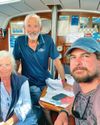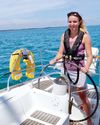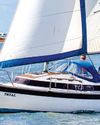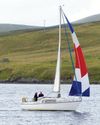
Biodiesel does not currently enjoy a good reputation among the boating community. Stories of blocked filters, diesel bug infestations, damaged fuel lines and corroded pistons have put boat owners off the very idea of using it. However, a new generation of renewable diesel that is chemically identical to fossil-based diesel but cuts carbon dioxide emissions by 90% could prove to be the quickest and simplest route to a cleaner, greener boating future.
It sounds almost too good to be true and yet this fuel already exists and is currently in use in some cars, aeroplanes and even commercial boats. So what is it, how is it made, how come it's not yet readily available to leisure boat owners, and is it really the silver bullet we've all been waiting for? We've spoken to the experts at renewable fuel specialists Neste and engine builders Rolls-Royce MTU to bring you the answers.
What is HVO renewable diesel?
Hydrotreated vegetable oil (HVO) or renewable diesel are two of several terms used to describe a new generation of bio-based diesel that's much cleaner-burning and far less prone to problems than the first generation FAME (fatty acid methyl ester) biodiesel.
This new generation of renewable diesel is a clear, colourless, odourless liquid that is chemically almost identical to the main component in fossil-based mineral diesel. It has all the same key characteristics and none of the drawbacks of either mineral or FAME biodiesel. In fact, it actually burns cleaner than fossil diesel because it lacks the naturally occurring impurities and aromatic hydrocarbons that give fossil-based diesel its distinctive colour and smell.
This story is from the November 2023 edition of Practical Boat Owner.
Start your 7-day Magzter GOLD free trial to access thousands of curated premium stories, and 9,000+ magazines and newspapers.
Already a subscriber ? Sign In
This story is from the November 2023 edition of Practical Boat Owner.
Start your 7-day Magzter GOLD free trial to access thousands of curated premium stories, and 9,000+ magazines and newspapers.
Already a subscriber? Sign In

Orca sink yacht in Strait of Gibraltar
Spain's maritime rescue service, Salvamento Maritimo, has reported that a 15m (49ft) yacht sank in Moroccan waters in the Strait of Gibraltar following interaction with a pod of orca.

No kill cord or lifejackets were worn during fatal powerboat crash
A kill cord and lifejacket are useless unless worn-that's the warning from the Marine Accident Investigation Branch (MAIB), following its investigation into a powerboat crash that killed a 32-year-old woman and five-year-old girl on 2 October 2022.

Multihull sail work
Brush up on multihull sailing skills before heading off on charter with Gavin Le Sueur's guide to spinnaker handling, tacking and gybing

Five top causes of engine failure and how to prevent them
Jake Kavanagh talks to Sea Start marine engineer Nick Eales about how to avoid the five major causes of an engine breakdown at sea

Sail the Atlantic with strangers
Would you sail across the Atlantic with someone you've just met? Ali Wood meets the cruising crews who've done just that

IZIBoat: simple sailing
Rupert Holmes sails an innovative catamaran design intended to widen participation in sailing among those with little time to get on the water in more conventional craft

30 WAYS TO GET AFLOAT
From tall ships to small dinghies, you needn't own a boat to sail. Ali Wood looks at the options, and how skippers can also find crew

Boats for restoring under £20,000
Duncan Kent picks the best sub-35ft sail and power boats to look for when aiming to undertake a restoration on a budget

Seaworthy dinghies for less than £500
For low cost traditionally-styled GRP trailer-sailers, consider the Foreland and the Otter available at bargain basement prices

Playing with coloured sails
Maintaining an hourglass-shaped balloon and ratcheting up the log numbers